Semana Santa in Acanceh, Yucatan
Acanceh (pronounced ah-cahn-KAY) means "dying deer" in Mayan and it's a bustling pueblo about thirty minutes from Merida, following the new highway south from the east-bound 180 toll highway. It is close enough to the White City that it can be considered a bedroom community, and certainly many of its inhabitants work in Merida or in the maquiladoras which pepper the countryside in that area.
This past Friday, the central plaza was emptied and covered with white gravel. This was to be the scene of the most compelling part of the events to come: the crucifixion of Jesus Christ. Surrounding one side of the plaza is a large Franciscan church, called La Natividad, a second church devoted to the Virgin of Guadalupe, and the town's mercado. On another side is the parque, with its fountain, trees, benches, topiary gardens and prominent deer statue. A third side has a row of business and residential buildings. The town is arranged using typical Spanish colonial design, with one exception. On the fourth side of the central plaza, you'll see something rather unusual, yet something Acanceh is known for: a Maya pyramid.
Archaeologists believe this and many of the other 400 Mayan structures of Acanceh were initially built during the early classic period, roughly 200-300 years A.D. and then elaborated through the late classic, around 1,100 A.D. The structure on the main plaza is usually called "The Pyramid". A climb to the top is rewarded in two ways. The first is a lovely view of Acanceh, including some of the other Mayan structures and the surrounding jungle. The second is a series of five "masks", which are large bas-relief sculptures made of stone and covered in stucco. These are currently protected from the elements by modern, corrugated fiberglass shelters, which also protect the visitor from the heat of the day. A bit farther to the south, you'll find the "Pyramid of the Stuccos", which also has bas-relief sculptures, these depicting human-like animal forms. Most still wear some of the bright pigments with which these ceremonial centers were originally painted.
Acanceh was an important destination between Mayapan, the last of the great city states in Yucatan, and T'ho (now called Merida). With the decline of the Toltec influence from the west and resulting civil wars between the city states, the Maya began to spread out and develop many smaller, self-contained villages based on agriculture and trade. While many of the former city states were maintained as ceremonial centers and pilgrimage destinations, they were no longer the center of Maya daily life. When the Spanish arrived, they soon recognized the situation. They co-opted the Maya caciques (chiefs) and built churches at the Maya ceremonial centers using stone retrieved from the pyramids. For this reason, most of the important colonial towns and cities of Yucatan show few traces of Mayan architecture, two notable exceptions being Izamal and Acanceh.
The Maya of Acanceh devoted themselves to the Catholic faith with great reverence and have cultivated one of the most elaborate and authentic of the Passion Plays performed around the Yucatan Peninsula during Semana Santa or Easter Week. As all Christians know, the Passion of the Christ is a play performed since the European medieval period that portrays the traditional story of the last hours in the life of Jesus. The Play begins around noon, takes roughly two and a half hours to unfold and is performed at several different locations around the center of town. It begins with the first trial before Pontius Pilate and includes the audience before King Herod, return to Pilate, the release of Barabas, the scourging and humiliation, the Via Cruces (procession though the streets with re-enactments of the twelve stations of the cross) and the crucifixion. If you pay close attention, other events occur on the side, including the suicide of Judas. These scenes are all portrayed in Roman and Middle-Eastern costumes, with serious devotion on the part of the huge Maya cast, so don't be surprised if the overall effect transports you to an unexpected time and place, a juxtaposition of several ancient cultures.
Before and after the play, the people of Acanceh and their visitors are in quite a festive mood. There are plenty of puestos (booths) set up for buying refreshments and recuerdos (mementos) during the day. The churches, shops and archaeological zone are all open as well. Although the weather on the day we visited was pleasant, be sure to wear a hat, good walking shoes and bring your favorite bottled water, because you may find yourself spending more time in the Yucatan's outdoors than you normally would.
The video below is in two parts. The first is a short tour around Acanceh prior to the Passion Play. The second part is a (very) edited version of the Passion Play itself and may not be suitable for all viewers. However, despite appearances, no one is actually harmed during the performance. While we admit that the actor who plays Jesus endures an undoubtedly grueling experience, the effects are (mostly) stagecraft and, unlike some other performances around the world, no serious injuries are inflicted.
Read last year's article about Semana Santa in Merida.







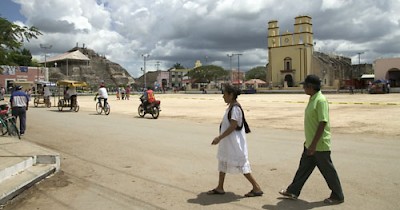
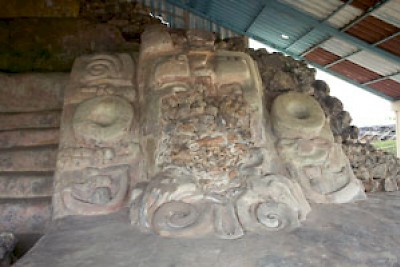
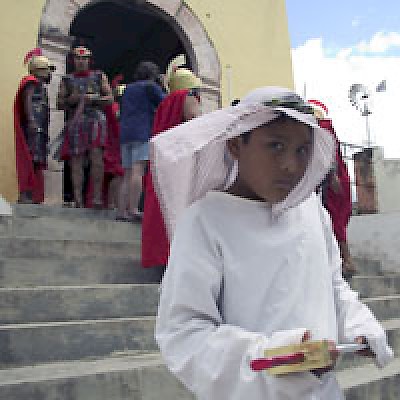
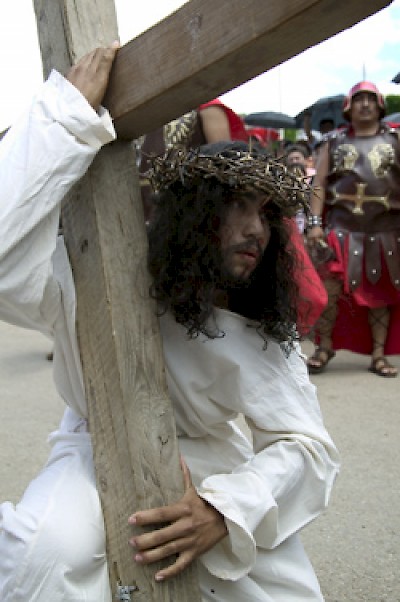
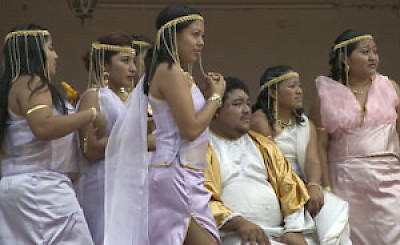

Comments
oscar 16 years ago
Todo lo que se pueda hacer para dar a conocer otra cara del acanceh verdadero es bienvenido, nuestros orÃgenes no podemos negarlo y no debemos dejar que perezcan nuestras costumbres y tradiciones ancestrales por el cambio globalizado que nos engulle mediaticamente sin darnos cuenta. acanceh tiene mucho que ofrecer a la comunidad local y extranjera. BIENVENIDOS, amigos!
Translation (approx): Anything that can be done to show the other and real side of Acanceh is welcome. We can´t deny our origins and we shouldn’t let our customs and ancestral traditions die because of globalized change that takes us in without even noticing. Acanceh as a lot to offer to the local and foreign community, WELCOME friends!
Reply
Roger 17 years ago
Yo soy de Acanceh y cada que veo mi pueblo me da mucha nostalgia,gracia por esas bellas tomas.
Reply
gladys medina 17 years ago
mi comentario es agradesco todo loque asen para informarnos anosotros que estamos lejos de nuestro origen muchas gracias
Editor's Translation: My comment is to thank all of you that make this website, so that those of us who live far away from home can know what is going on. Thank you very much!
Reply
Manuela Nino 19 years ago
I send my love and gratitude to you and your friends that take the time to get to know Merida and its surroundings. I was born in Merida, 53 years ago, but living in the U.S. for 35 years. I visit my family once in a while, but it is nice to be able to see some videos of my Yucatan that I love so much. It makes me feel nostalgic. Thank you very much for your hard work and love for Yucatan.
Reply
x0x go0dgurl x0x 19 years ago
THIS IS PRECIOUS... I LOVE JESUS AND THANKS FOR THIS BEAUTIFUL SITE....I LOVE IT !
Reply
Jean-Yves 19 years ago
Magnifique spectacle que celui de Acanceh!
La meilleure reconstitution de la Passion que je connaisse.
Je reviendrai en 2007 pour vivre à nouveau la "passion" des Mexicains pour cette période de la vie du Christ.
Je conseille la grande messe de Uman, le soir, pour achever les fetes de la Passion.
Mes photos et videos sur la Passion depuis plusieurs années.
http://hatuey.blogs-de-voyage.fr/tag/Passion+du+christ
slideshow: http://hatuey.blogs-de-voyage.fr/album/mexique/page1/
Reply
Joseph 19 years ago
Sadly, seems like some photographers here don't know that there are lenses above 20mm and had to get their cameras into one of Jesus' nostrils just to get a shot of his face.
As Working Gringo told me: No photographic courtesy from them, at all.
Reply
Working Gringos 19 years ago
Oye, Copykid. Thanks for the comments. We probably will post some stills of the event in our Photo Gallery, but if you have posted yours somewhere, we'd be pleased to link to them.
Reply
Copykid 19 years ago
Thanks so much for the video!. We were there this year with our two teenage boys and were throughly amazed by the production. I have to add also, as seen on the video, the photographers were everywhere. It really took something away from the experience and I think also removed some of the "reverence" that should be shown at such an event. I couldn't get a single photo without several photographers in the shot. (By the way, I have some "great shots" of you also...LOL) Are you going to post some "still shots"?
Thanks Again
Reply
Dan 19 years ago
Wonderful! It almost seems from another era, another time.
Reply
Working Gringos 19 years ago
Thanks, Reg. They do put on a world-class show. As for those photogs, the Mayan-Judeo-Christian syncritism wouldn't be complete without some modern cultural dissonance. Today's spectacle of humiliation requires at least a dozen photographers literally in your face. ;)
Reply
(0 to 11 comments)Next »